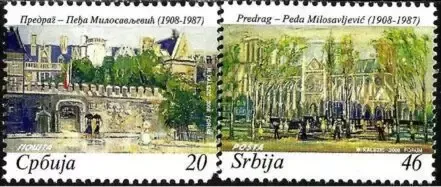Serbia Principality year 1876 40 para postage stamp
The Principality of Serbia between 1866 and 1880 was a period marked by significant political, social, and economic changes. Here’s an overview of the key events and developments during this time:
Political Context
- Ruling Monarch: The period began under the rule of Prince Mihailo Obrenović III, who reigned from 1860 until his assassination in 1868. His successor, Prince Milan Obrenović IV, ruled from 1868 to 1882, when Serbia was proclaimed a kingdom.
- Autonomy and Independence: This era was significant for Serbia’s movement towards full independence from the Ottoman Empire. The Treaty of Berlin in 1878 recognized Serbia as an independent state.
Key Events
- Assassination of Prince Mihailo Obrenović III (1868): Prince Mihailo was assassinated in 1868, leading to political turmoil. He was succeeded by his cousin, Milan Obrenović IV, who was initially a minor, leading to a regency until he came of age.
- Milan Obrenović IV’s Rule: Milan came to power in 1868, initially under a regency, and later ruled as the prince. His reign saw efforts to modernize the state and increase its autonomy from the Ottoman Empire.
- Reforms and Modernization: During this period, Serbia underwent significant administrative, military, and educational reforms. Efforts were made to modernize the economy and infrastructure, including the construction of railways and improvements in agriculture.
- Balkan Alliances and Wars: Serbia engaged in various diplomatic and military activities aimed at reducing Ottoman influence and expanding its territory. This included participation in the Balkan Wars.
Social and Economic Developments
- Education: There was a significant focus on expanding education, with the establishment of new schools and institutions of higher learning.
- Economic Growth: Efforts were made to modernize agriculture and develop industry. Trade increased, and there was a focus on building infrastructure like roads and railways.
- Military Reforms: The military was reorganized and modernized, with the establishment of a standing army and improvements in training and equipment.
International Relations
- Austro-Hungarian Influence: Austria-Hungary had significant influence over Serbian politics and economics, leading to a complex relationship.
- Russian Support: Russia was seen as a traditional ally and supporter of Serbian independence efforts.
Independence and the Treaty of Berlin (1878)
- Recognition of Independence: The Congress of Berlin in 1878 was a pivotal moment for Serbia, as it formally recognized Serbia as an independent state, free from Ottoman suzerainty.
- Territorial Expansion: Serbia gained additional territories as a result of the treaty, expanding its borders and increasing its strategic importance in the Balkans.
Cultural Developments
- National Identity: There was a growing sense of national identity and cultural revival. Efforts were made to promote Serbian language, literature, and history.
- Orthodox Church: The Serbian Orthodox Church played a crucial role in national identity, with increasing influence on cultural and educational matters.
Conclusion
The period between 1866 and 1880 was transformative for the Principality of Serbia. Under the rule of Prince Milan Obrenović IV, Serbia made significant strides towards full independence, modernized its institutions, and laid the foundations for future growth and development. The recognition of independence in 1878 marked the culmination of these efforts, setting the stage for Serbia’s eventual proclamation as a kingdom in 1882.











Reviews
There are no reviews yet.